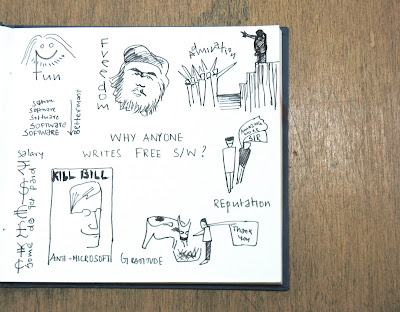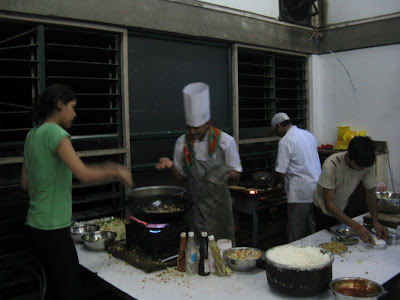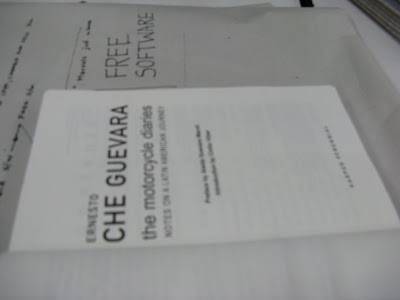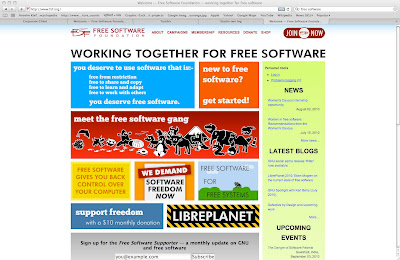FLOSS - Free/Libre/Open source software for designers. This is the central theme of this academic-studio project.
Tuesday 23 November 2010
Rebranding google summer of code
a) Google summer of code as a brand is communicating to only coders.
Software = code + design + much more.
Google Code-In is including non-code like documentation, user experience research inside it. But the target students for those jobs are not coders. Hence the brand should become
Google summer of software
=
Google summer of code + design + much more.
b) Google summer of code has suffered major renaming. See its history
Google highly open participation contest
Google summer of code
Google Code-In
Next what ?
Brand name is limiting its growth.
b) While targeting non coders, especially designers, the brand needs to be well designed.
The communication to them like web banners or posters or t-shirts needs to be well designed.
Solution "Design for open source"
a) regular design requests for open source projects
b) education about open source to design schools
c) articles
Other services should be
a) moderated addition of fresh design requests
b) rss or email updates to visitors
This web page needs hosting ( possible with wordpress ).
This web page needs visibility among design schools
Thursday 28 October 2010
Solution OpenNeed
Philosophy: "Open source solution follows open need expression"
Dissatisfaction with existing publication design software. publication design process is not stressed or obvious or encouraged in Indesign or Scribus. Publication design decisions logic can be expressed visually.
Solution analysis summer of design
- Can be suggested to Google and become reality.
- Attracts design students because of stipend and Google job possibility
Summer of design 2011
Contributing to commons( Essentials added to commons reduce monopoly )
Potential job at Google
Software knowledge
Know open source history, culture
Developers started it.
Design needs singular vision -
Time line of summer of design and process.
(The process of this summer of design.)
Promotional posters.
- First stop open source and next stop is google.
- Flight hop to open source and next destination is google.
- Step one open source and step two google.
- What did you do during open source revolution daddy ? Developer dad:I coded, What did you do during open source revolution daddy ? Designer dad: blank.
- Graphic user interface development for new projects
- Graphic user interface redesign for existing projects
- Graphic user interface addition to existing projects
- Publication design and illustration (Operating system bible) for fedora operating system
- Regional digital typeface design for ubuntu OS, Fedora OS.
- Designing marketing collaterals(CD/DVD covers, Tshirt design, posters, banners) for fedora, ubuntu studio, gimp,
- 2D art(animated characters and tiles) for The goblin and the butterfly
- 3D modeller (Maya/3DSMAX/Blender) for Trinity
- Graphic design ( User interface, logo and website) for OpenRCON
- Designing the installer/setup program of opit browser
- Visual identity for open source portal HumanPortal
Tuesday 26 October 2010
Jury feedback
Sanjay: How does the open source economy works ?
Sanjay: Do you think the comic book will work in NID ?
Sanjay: Open source is for developers why should designers care ?
Tridha: Why the word "Gratis" in the animation film ? Will it work in Indian scenario ?
Tridha: Stuck during solution generation
Rupesh: There are no tangibles
Friday 8 October 2010
Solution phase - Create FLOS projects.
Space for FLOS projects
Sourceforge.net provides space to create your own FLOS project.
http://sourceforge.net/register/
Google summer of code is an intiative to fund the open source projects
If it is a design project you can follow the open design process suggested as below:
Open source design process:
http://www.markboulton.co.uk/journal/comments/design-in-open-source#more-768
http://www.smashingmagazine.com/2010/09/01/the-case-for-open-source-design-can-design-by-committee-work/
Solution phase - Participate in FLOS projects
Redesigning FLOS product
- Every FLOS product is open to redesign. Designers can redesign it along with the developers.
- Design students can redesigning/designing for FLOS products as academic projects, class assignments.
- Design teachers can encourage students take up redesigning/designing for FLOS products.
Designing FLOS products
Developers are expecting designers to contribute in design works like: Logo design, Icon design,Poster design,T-Shirt design,CD/DVD cover design,Website design,Color scheme design,Illustration,Font design and more.Such jobs can be found at below links:
Design jobs for open source projects
Design art work for ubuntu open source operating system project
Design jobs for mozilla open source project
Design art work for fedora open source operating system project
Re-design for Gimp
and much more..
Solution phase - Consume the FLOS products
Adobe Photoshop
Adobe Illustrator
Adobe Indesign
Fontlab
Flash
3DS MAX
Premier pro
Windows Mac OS
MS Word
For more check the below links:
http://www.osalt.com/
http://directory.fsf.org/
Solution phase - Consider the FLOS need
Videos:
Definition of open source
Advertisement for linux
What is copyleft ?
What is history of open source ?
What is FLOS ?
Why FLOS is better than piracy ?
Solution set
a) Consider the FLOS need.
b) Consume the FLOS products.
c) Contribute to FLOS projects.
d) Create FLOS projects.
Friday 24 September 2010
FLOS Typefaces resource
http://openfontlibrary.org/files
http://www.theleagueofmoveabletype.com/
http://www.smashingmagazine.com/2007/11/08/40-excellent-freefonts-for-professional-design/
http://www.designwritingresearch.org/free_fonts.html
http://crudfactory.com/fontserver/show
http://sourceforge.net/projects/crimsontext/
http://sourceforge.net/projects/beteckna/
http://sourceforge.net/projects/amiri/support
The typeface development can be sponsored by online multiple donors method like below:
http://sourceforge.net/project/project_donations.php?group_id=344961
The typeface projects can be developed by organizations too like below:
http://wiki.creativecommons.org/Grants/Open_Font_Library
http://openfontlibrary.org/patrons
http://code.google.com/p/sortsmill/
Thursday 2 September 2010
FLOSS Designers = Designers for FLOSS
Interestingly some professor is on it,
http://www.sububi.org/2010/08/18/free-interaction-design-for-your-open-source-project/
Where FLOSS designers can contribute are :
http://sourceforge.net/people/
FEDORA
http://fedoraproject.org/wiki/Artwork
SCRIBUS
Contributing back to Scribus
http://wiki.scribus.net/index.php/How_can_I_contribute_to_Scribus%3F
Design tips can be added at this page
http://wiki.scribus.net/index.php/Avoiding_Design_Problems
More features can be added in similar section
http://wiki.scribus.net/index.php/Discussion:_Practical_Needs_in_Layout_Software
( Post expected to grow with more information)
Project scenarios presentation
Talk with guide
Comparision of tool
Tool analogies
Publication design is space design
Tuesday 31 August 2010
Open need as solution strategy
 |
Graphic designers explaining basics of graphic design to a developers and Me acting as the bridge between NID and OSI, Open Source Intiative |
 |
| Review feedback expressed in the "E-verification software for similar looking logos." |
 |
| Logo expression of NID becoming Open source development hub |
 |
| Open need logo derivation from open source initiative logo |
 |
| Open need expression in form of use-cases and available in commons. |
Possible content for publication design
Publication design is something which is difficult to learn outside the institute. The solution set which has publication design element will be executed for the essential experience of publication design. The major issue with publication design is to grab a ready and simple content else the content generation itself can consume the project weeks. An analysis of suitable content was done as shown in the below image.
Problems, scenarios, solutions, strategies
Reviews online about FLOSS for graphic design
Saturday 28 August 2010
A photography student's experience

Thursday 26 August 2010
FLOSS usability issues for designers and its root cause
The presentation
The below link takes you to the PPT presentation which describes the above with a brief introduction to the subject of the project, "FLOSS for designers".
Data presentation metaphor
Data synthesis


Doodle : Creative commons
Another interesting offspring of Free soft licensing is creative common licensing. Very nice visual interventions like creating visual symbols and visual dominated summary of license text are executed. Even the website is very easy to consume. Create commons is interesting concept to encourage people to contribute to commons and decide their stand from copyleft to copyright.

Why would anyone write free software ?
Why anyone would write free software was one interesting question which lot of us are curious about ? And here is a doodle to explain it. courtesy: http://www.gnu.org/philosophy/fs-motives.html

Open source and NID night mess
A excellent analogy of open source software is the night mess at NID hostel. The kitchen is open to access, open to change, open to share. And open source doesn’t mean free of cost and so is the kitchen.


Data collected
The data collection ended. The notes are displayed in the form of “Open source initiative” logo. It was very interesting phase. One can get lost in the data collection. Hence the constant remainder to centre around the main theme of project, “FLOSS for designers”.
“You, designers can spend lot of time to understand the content but remember someone is spending his life on the content. You can never become expert and that is not the motive.” - Roughly the words uttered by Immanuel Suresh

Data collection : NGO in a box
Tactical technology, an international NGO had brilliantly designed a solution for NGO across the world. They are providing the essential Free/Libre and Open source softwares (FLOSS) to NGOs in a kit. Few FLOSS are not matured enough to be used in professional works but are very handy for amateur works. Well conceived, executed project.

Wednesday 25 August 2010
Data collection : Hackers
The roots of FSF leads to hacker community. This word was again abused to mean illegal privacy breachers. Actually hackers definition goes like “A person who delights in having an intimate understanding of the internal workings of a system, computers and computer networks in particular.” This emblem of hackers was designed by Eric S. Raymond and is a representation of a glider formation in Conway’s Game of Life.
Data collection : Free software foundation
Where else but fsf.org, the free software foundation portal, the authentic data bank about free software movement. Portal talks about the free software movement’s philosophies, how open source differs, different campaigns, licenses and resources. The crux of common misunderstanding was “FREE IS NOT ABOUT PRICE BUT ABOUT FREEDOM”.
The categorized data
Brainstorming : Categorized data
Brainstormed data was categorized and transfered to a new sheet. The image shows the categorization in process.
Brainstorming categorization using s/w
Now the brainstorming sheet contents need to be categorized. An attempt was made with the brainstorming software called XMind’ “GRATIS” version but decided against proceeding further. This is because of a) difficulty to reproduce doodles and drawings as a brainstorm content b) difficulty in exporting image output files.
Initial communication need
Creating awareness about free software and open source software among design students in NID.
Before writing proposal for this self-initiated project, I wanted to validate my assumptions that design students in NID aren’t much exposed to free softwares and open source softwares. Hence short interviews and brainstorming happened which were recorded in a sheet. These recordings will be categorized and developed upon later. The image below is the brainstorm record sheet.























